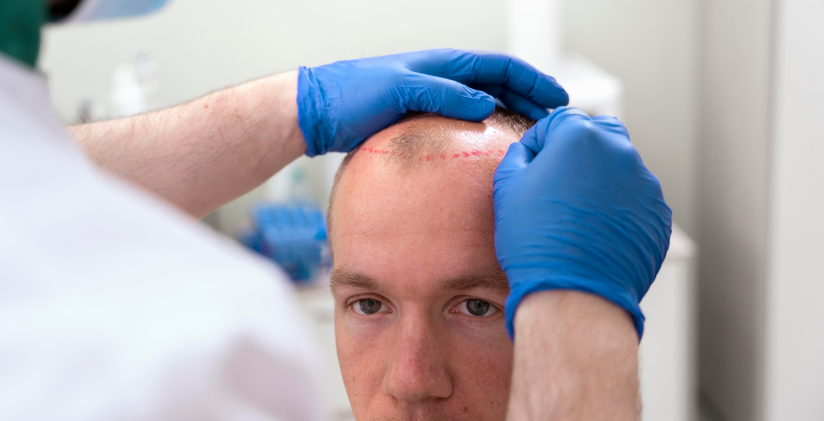How SMP Can Treat Alopecia

Scalp Micro Pigmentation (SMP) is a non-surgical hair loss treatment that uses detailed micro-needles to deposit pigment into the scalp. This innovative technique mimics the appearance of natural hair follicles, providing an illusion of a fuller head or thicker hair. It's a revolutionary method for treating a range of hair loss conditions such as androgenetic alopecia, alopecia areata, and hair thinning.
The beauty of SMP is it offers immediate results, with minimal upkeep and virtually no significant side effects. It is an ideal solution for those seeking an alternative to hair transplant surgeries or medications. Whether you want to fill in thinning areas, create a new hairline, or cover up scalp scars from past hair transplants, scalp micropigmentation provides a versatile solution for various hair loss issues.
Understanding Alopecia
Alopecia is a term used to describe hair loss on the scalp or other parts of the body. There are several types, with varying degrees of severity and causes. The most common form, androgenetic alopecia, also known as male pattern baldness or female pattern baldness, is often hereditary and can affect both men and women. Alopecia areata is an autoimmune disorder where the body's immune system attacks hair follicles, leading to patchy hair loss. More severe forms of alopecia areata include alopecia totalis, which involves loss of all hair on the scalp, and alopecia universalis, which results in loss of all hair on the body. Understanding the type of alopecia one has is crucial to finding the most effective treatment approach.
Types of Alopecia
Androgenetic Alopecia
This is the most common type of hair loss, affecting both men and women. In men, it's often referred to as male pattern baldness, characterized by hair loss starting from the crown and the temples. In women, this form presents as thinning hair all over the scalp, but mostly at the top.
Alopecia Areata
This is an autoimmune disorder resulting in the body's immune system attacking its own hair follicles. It typically starts with one or two patches of hair loss on the scalp and can progress to total scalp hair loss (alopecia totalis) or complete body hair loss (alopecia universalis).
Traction Alopecia
This type of hair loss is caused by pulling force being applied to the hair, such as tight hairstyles, leading to damage in the hair follicles.
Telogen Effluvium
This is a temporary form of hair loss where more hairs than normal prepare to fall out. It's usually triggered by physical or emotional stress.
Cicatricial (Scarring) Alopecia
This rare type of alopecia results in hair follicles being destroyed and replaced by scar tissue, causing permanent hair loss.

Causes and Triggers of Alopecia
Alopecia is a multifaceted condition with diverse triggers and causes, varying according to the type of alopecia. Here are some common causes:
- Genetics: Androgenetic alopecia, the most prevalent type of hair loss, often runs in families. It is primarily caused by sensitivity to a hormone known as DHT (Dihydrotestosterone).
- Autoimmune Response: With alopecia areata, the immune system mistakenly targets and damages hair follicles. The exact reason for this immune response isn't known, but it's often seen in individuals with a family history of other autoimmune conditions.
- Physical Stress or Trauma: Conditions like Telogen Effluvium can be triggered by significant physical stress, surgery, illness, or drastic weight loss.
- Hairstyling Practices: Traction alopecia arises from prolonged tension or pulling on the hair, as seen with certain hairstyles or treatments that strain the hair follicle.
- Scarring Events: Cicatricial Alopecia results from damage to the hair follicle due to scarring events such as infections, burns, or other skin conditions.
Benefits of Scalp Micropigmentation (SMP) for People With Alopecia
Scalp Micropigmentation (SMP) has emerged as a highly effective solution for individuals suffering from various forms of alopecia. This innovative treatment offers numerous benefits, providing a sense of renewed confidence and wellbeing for those grappling with hair loss. Here are some key advantages to consider:
Non-Surgical
Scalp micropigmentation is a non-invasive procedure, unlike hair transplant surgeries. This aspect eliminates potential surgical complications or discomfort, making it a suitable choice for those who prefer not to undergo surgical interventions.
Instant Results
Unlike other treatments that may take months to show results, the visual effect of SMP is immediate. After treatment, clients can instantly observe the illusion of a fuller head of hair.
Long-Lasting
The results of SMP are relatively long-lasting, with the effects typically visible for several years. While touch-ups might be needed over time, the initial results can be maintained with minimal upkeep.
Cost-Effective
In comparison to ongoing costs of medications or repeated hair transplantation surgeries, SMP can be more cost-effective in the long run.
Versatility
SMP can be used to address various types of alopecia, from pattern baldness to alopecia areata. It also allows individuals to choose the shape and style of their new hairline, offering a highly customizable solution.
Low Maintenance
Once healed, an SMP treated scalp requires very little maintenance. This freedom can simplify one's daily routine and reduce stress related to hair care.
Boosts Confidence
Perhaps the most significant benefit is the boost in self-confidence. Hair loss can majorly impact self-esteem, and scalp micropigmentation can help restore this by providing the illusion of a fuller head of hair.
Scalp Micropigmentation indeed revolutionizes the way alopecia is treated, providing individuals a non-surgical, long-lasting, and cost-effective solution. By adopting scalp micropigmentation, individuals can reclaim their confidence and face the world with renewed optimism. However, it’s crucial to consult with a professional practitioner to understand the procedure, maintenance, and potential risks thoroughly before deciding on this treatment.

How Scalp Micropigmentation Works for Alopecia
Scalp Micropigmentation (SMP) is a specialized process that uses tiny needles to inject pigment into the scalp, replicating the appearance of natural hair follicles. The procedure is akin to receiving a tattoo, albeit on a minuscule scale, and requires precision and expertise.
For individuals with alopecia, SMP provides an illusion of density in areas where hair has thinned or ceased to grow. In instances of total hair loss, it can create an entirely new hairline and the appearance of a shaved or buzzed hairstyle.
The scalp micropigmentation process begins with an initial consultation, where the practitioner discusses the client's needs, preferences, and the desired outcome. Following this, the treatment is administered over several sessions, with each session lasting about two to three hours.
The length and number of sessions depend on the extent of hair loss and the client's scalp condition. After the procedure, the client may experience some redness and minor swelling, which generally subsides within a few days.
To maintain the appearance created by scalp micropigmentation, occasional touch-ups may be needed, but the results are typically long-lasting. It's essential to note that SMP does not prevent or cure alopecia but offers a cosmetic solution that can help individuals cope with hair loss more confidently.

